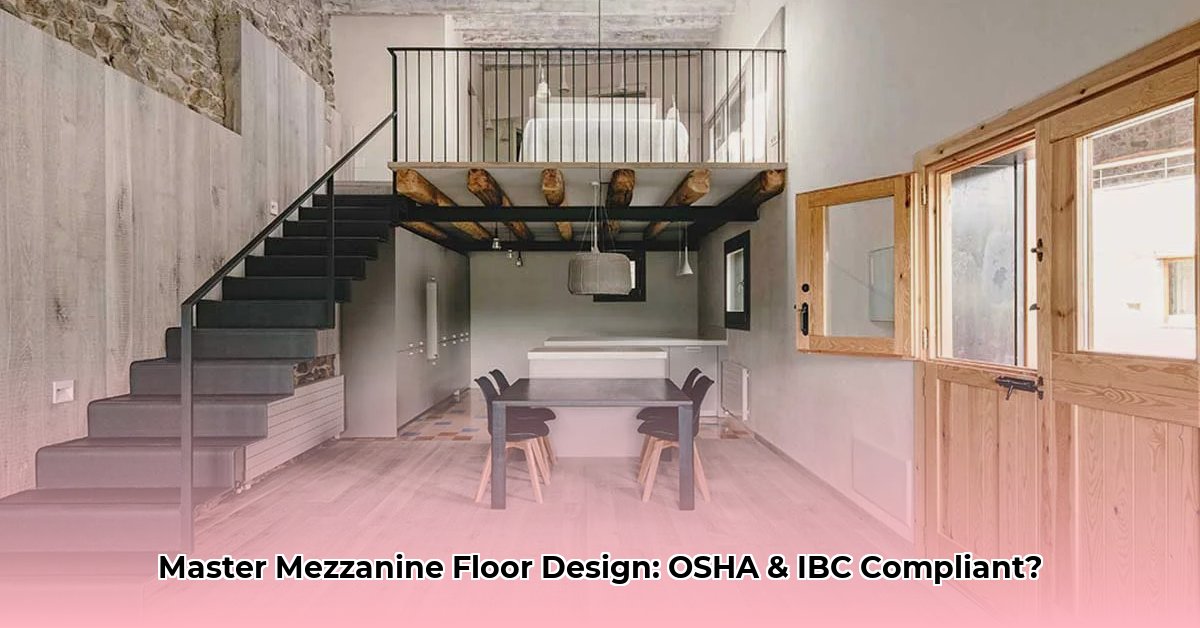Thinking about adding a mezzanine floor to your building? It’s a significant project, and correctness is paramount for safety and cost-effectiveness. For more information on mezzanine floors, check out this helpful guide. This guide clarifies jargon and details designing a compliant mezzanine. We’ll compare OSHA and IBC rules, outline building steps, and provide maintenance tips. This roadmap suits business owners, facility managers, and builders alike.
Mezzanine Floor Design Standards: Your Guide to Safe and Compliant Structures
Building a mezzanine involves more than creating extra space; it’s about legal compliance and ensuring a safe environment for all users. This guide simplifies mezzanine design, focusing on code adherence and safety best practices. Non-compliance can lead to significant fines, operational delays, and, most importantly, safety hazards.
Navigating the Rules of the Game: OSHA and IBC
Building codes are the rules of construction. The Occupational Safety and Health Administration (OSHA) focuses on worker safety during construction and occupancy. The International Building Code (IBC) is a broader set of model building codes addressing overall building safety and structural integrity. They ensure safety for people and the building’s long-term viability. Both are essential. Overlooking these regulations can lead to penalties and accidents.
Designing Your Mezzanine: Key Steps to Success
Safety in mezzanines involves careful planning and execution:
- Solid Foundation: Structural Integrity: Weight capacity is primary. Calculate dead load (weight of the mezzanine structure itself) and live load (weight of occupants, equipment, and stored materials). A structural engineer is vital to validate the support structure and ensure it meets or exceeds required safety margins.
- Fire Safety First: Use fire-resistant materials and incorporate protective designs. This includes fire-retardant coatings, sprinkler systems, and compartmentation to prevent fire spread. Consider fire alarms and suppression systems that meet code requirements.
- Escape Routes: Egress Planning: Plan for easy and safe evacuation. IBC Chapter 10 details specific requirements for egress, including the number and width of exits, travel distances, and emergency lighting. Clear and well-marked exits are essential for preventing panic and ensuring swift evacuation.
- Access for All: Accessibility: Comply with the Americans with Disabilities Act (ADA) for public spaces and consider options that promote inclusivity. Options such as ramps, elevators, and accessible stairways ensure that everyone can access and use the mezzanine safely and comfortably.
Choosing the Right Materials: Weighing the Pros and Cons
Material options include steel, wood, and concrete. Each has distinct advantages and disadvantages:
| Material | Advantages | Disadvantages |
|---|---|---|
| Steel | High strength-to-weight ratio, non-combustible, recyclable, versatile in design and application. Can withstand significant loads and seismic activity. | Higher initial cost compared to wood, susceptible to corrosion if not properly treated. Requires specialized equipment and skilled labor for fabrication and installation. |
| Wood | Relatively inexpensive, aesthetically pleasing for certain applications, renewable resource. Easier to work with and modify than steel. | Lower strength and load-bearing capacity compared to steel, susceptible to fire damage, moisture damage, and insect infestation. Requires regular maintenance and treatment to prolong its lifespan. |
| Concrete | Extremely strong and durable, excellent fire resistance, can be molded into various shapes and sizes. Provides good sound insulation. | Very heavy, less flexible than steel or wood, requires significant formwork and curing time. Difficult to modify or demolish once in place. |
| Aluminum | Lightweight, corrosion-resistant, and recyclable. Suitable for applications where weight is a primary concern or in environments with high moisture exposure. | Lower strength compared to steel, more expensive than steel or wood, can be susceptible to galvanic corrosion when in contact with dissimilar metals. |
| Composites | Can be engineered to provide specific properties such as high strength, light weight, fire resistance, and corrosion resistance. Offers design flexibility and can be molded into complex shapes and sizes. | Higher initial cost compared to traditional materials, requires specialized manufacturing processes, long-term performance and durability may not be fully established for all applications. |
The optimal choice depends on project needs, budget, and aesthetic preferences. Consider all factors, including load requirements, fire safety regulations, environmental conditions, and long-term maintenance costs.
Working with What You’ve Got: Integrating with Existing Systems
Adding a mezzanine to an existing building involves careful coordination with heating, ventilation, air conditioning (HVAC), electrical wiring, plumbing, and the existing lighting system. This ensures seamless integration and prevents disruptions to building operations. Consider these steps:
- HVAC: Evaluate whether the existing system can adequately serve the mezzanine level. You might need to extend ductwork or install additional units.
- Electrical: Plan for sufficient outlets and lighting. It should meet occupancy needs for safety and productivity.
- Plumbing: Necessary for constructing bathrooms and breakrooms. This will also need to consider ADA for disability access.
The Importance of the Experts: Professional Help Is Essential
Engage structural engineers, licensed contractors, architects, and fire safety consultants. They ensure correctness, safety, and regulatory adherence. Their expertise can save time, money, and potential legal liabilities.
Keeping it Safe: Ongoing Maintenance and Inspections
Regular inspections are crucial for identifying and preventing potential issues, extending the mezzanine’s lifespan, and maintaining a safe environment. Key aspects of maintenance include:
- Structural Inspections: Inspect for corrosion, cracks, or loose connections.
- Safety Equipment Inspections: Check guardrails, fire extinguishers, and emergency lighting regularly.
- Cleaning: Keep the mezzanine floor clean and free of debris to prevent slips, trips, and falls.
- Load Management: Enforce weight limits and ensure that loads are evenly distributed.
Following these steps facilitates a compliant and functional mezzanine. Safety and compliance are not just regulatory requirements; they are fundamental to responsible building design and management.
How to Navigate Varying State-Specific IBC Mezzanine Floor Code Requirements
Key Takeaways:
- IBC Section 505.2 guides mezzanine regulations, but state-level changes exist.
- Jurisdictional variances occur in area limits, height minimums, and egress regulations.
- Consulting engineers licensed in the specific jurisdiction is non-negotiable to ensure compliance and forestall costly revisions.
- Close attention and detailed understanding of local codes is needed when following IBC 505.2.
- Engineer designs can provide code flexibility, but expertise is a must.
Understanding the IBC’s Foundation: Section 505.2
The International Building Code (IBC) Section 505.2 serves as the foundational guide for mezzanine floor regulations. It establishes key parameters such as maximum allowable area (typically one-third of the room’s area), minimum headroom clearances (7 feet above and below the mezzanine), and stringent egress requirements. These regulations are designed to prevent structural failures and ensure swift and safe evacuations. The IBC is a model code, meaning states and local jurisdictions can adopt it, modify it, or create their own building codes.
State-Specific Variations: The Challenge
Variations can be significant. While the IBC offers a baseline, individual states can alter, interpret, or override its provisions. Acceptability varies widely depending on the state and local building authority.
Key Areas of Variation and How to Address Them
Variations can include:
- Area Limitations (IBC 505.2.1): The one-third rule isn’t universal. Some states impose stricter limits; others allow exceptions based on factors such as building occupancy and fire suppression systems. Research and understand the specific area limitations in your jurisdiction.
- Egress Requirements (Chapter 10): State adoption of IBC and local additions determine egress requirements. Stair widths, travel distances to exits, and emergency lighting requirements can vary significantly. Ensure your egress design meets or exceeds the most stringent applicable requirements.
- Openness Stipulations (IBC 505.2.3): Openness rules can vary. The exceptions, such as for low occupant loads or the presence of fire suppression systems, might be interpreted differently among states. Verify the specific openness requirements and allowable exceptions in your jurisdiction.
- Interactions with Other IBC Sections: Section 505.2 doesn’t exist in isolation. Interactions with other sections, like Section 503.1 (building area and number of stories) and Chapter 6 (Types of Construction), must be carefully considered. Understand how these sections interact with Section 505.2 in your jurisdiction.
A Step-by-Step Approach to Compliance
Adhere to these steps to ensure compliance with state-specific IBC regulations:
- Identify Applicable Codes: Determine the specific IBC edition and any state/local amendments or supplements. Contact the local building authority or consult a qualified engineer to identify all applicable codes and regulations.
- Engage a Qualified Engineer: Consult an engineer licensed in your specific state and experienced in mezzanine design and code compliance. Their expertise is crucial for navigating the complexities of local codes and regulations.
- Thorough Design Review: Have the engineer comprehensively review the mezzanine design for code adherence. Address any potential issues or discrepancies before submitting plans for approval.
- Permitting Process: Submit plans to the building authority for review and approval. Be prepared to
- Glass Tile Shower Ideas to Create a Stunning Bathroom Space - December 7, 2025
- Glass Wall Tile Ideas for Kitchens and Bathrooms - December 6, 2025
- Glass Tile Bathroom: Create a Beautiful, Easy-Clean Space - December 5, 2025










